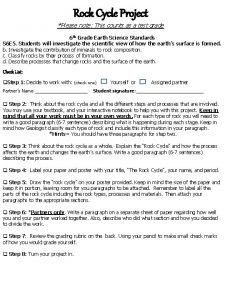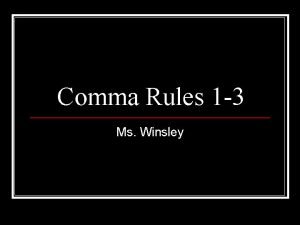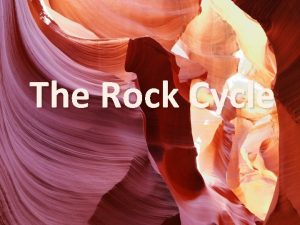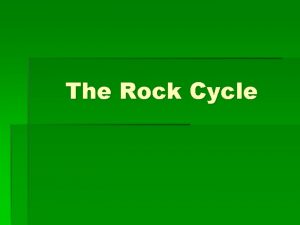Rock Cycle Project Please note This counts as



- Slides: 3

Rock Cycle Project *Please note: This counts as a test grade 6 th Grade Earth Science Standards S 6 E 5. Students will investigate the scientific view of how the earth’s surface is formed. b. Investigate the contribution of minerals to rock composition. c. Classify rocks by their process of formation. d. Describe processes that change rocks and the surface of the earth. Check List: q. Step 1: Decide to work with: (check one) Partner’s Name ___________ Yourself or Assigned partner Student signature: ______________ q Step 2: Think about the rock cycle and all the different steps and processes that are involved. You may use your textbook, and your interactive notebook to help you with this project. Keep in mind that all your work must be in your own words. For each type of rock you will need to write a good paragraph (6 -7 sentences) describing what is happening during each stage. Keep in mind how Geologist classify each type of rock and include this information in your paragraph. *Hints= You should have three paragraphs for step two. q Step 3: Think about the rock cycle as a whole. Explain the “Rock Cycle” and how the process affects the earth and changes the earth’s surface. Write a good paragraph (6 -7 sentences) describing the process. q Step 4: Label your paper and poster with your title, “The Rock Cycle”, your name, and period. q Step 5: Draw the “rock cycle” on your poster provided. Keep in mind the size of the paper and keep it in portion, leaving room for you paragraphs to be attached. Remember to label all the parts of the rock cycle including the rock types, processes and materials. Then attach your paragraphs to the appropriate sections. q Step 6: *Partners only. Write a paragraph on a separate sheet of paper regarding how well you and your partner worked together. Also, describe who did what section and how you decided to divide the work. q Step 7: Review the grading rubric on the back. Using your pencil to make small check marks of how you would grade yourself. q Step 8: Turn your project in.

Rock Cycle Project Grading Rubric Awesome! (4) Good Job! (3) Needs Improvement (2) Did Not Meet Standard (1) Student demonstrates a clear and accurate understanding of the formation and identification of the Igneous rock process. Student demonstrates a fair Student does not passably accurate understanding of the formation demonstrate an understanding of the and identification of the Igneous understanding of the formation and rock process, but needs formation and identification of the improvement. identification of the Igneous rock process. Sedimentary Rock Summary Student demonstrates a clear and accurate understanding of the formation and identification of the Sedimentary rock process. Student demonstrates a fair passably accurate understanding of the formation understanding of the and identification of the formation and Sedimentary rock process, but identification of the needs improvement. Sedimentary rock process. Student does not demonstrate an understanding of the formation and identification of the Sedimentary rock process. Metamorphic Rock Summary Student demonstrates a clear and accurate understanding of the formation and identification of the Metamorphic rock process. Student demonstrates a fair passably accurate understanding of the formation understanding of the and identification of the formation and Metamorphic rock process, but identification of the needs improvement. Metamorphic rock process. Student does not demonstrate an understanding of the formation and identification of the Metamorphic rock process. Student demonstrates a clear and accurate understanding of the stages of the Rock Cycle. Student demonstrates a Student demonstrates some good understanding of the stages of the Rock Cycle but needs Cycle. improvement. Igneous Rock Summary Rock Cycle Summary Diagram / Labels Penmanship Capital Letters and Punctuation Work Ethic Student does not demonstrate a measureable understanding of the stages of the Rock Cycle. Diagram included Diagram was neat, Diagram was not complete and it Parts of the diagram awesome details, was colored and included all was missing 1 -2 labels. and several of the colored and included all labels were missing. labels. Penmanship is neat and Penmanship is neat at Penmanship is somewhat legible Penmanship needs very legible. times but student may but students was rushing. improvement. have rushed a section. Penmanship needs Teacher was unable improvement. to read more than one section. Writer makes no errors in Writer makes 1 or 2 Writer makes a few errors in Writer makes several capitalization or errors in capitalization and/or punctuation errors in punctuation, so the paper or punctuation, but the that catch the reader's attention capitalization and/or is exceptionally easy to paper is still easy to and interrupt the flow. punctuation that read. catch the reader's attention and greatly interrupt the flow. Student worked very hard Student worked hard to Student was off task some to complete the project the during the project. Student’s the time provided, but was work ethic needs improvement. redirected to stay on task at less 1 time. Partner Assessment: ______ Student was off task for most of the assignment and work ethic needs to improve greatly. Grade: _____% Student comments: ______________________________________________________________ Teacher comments: ______________________________________________________________ Parent Signature: _________________

Rock Cycle Writing: Thinking Notes Igneous, Sedimentary, and Metamorphic Rock ü Define which rock you are talking about. üHow is it classified? (think about the different ways they are classified) üRemember to talk about how minerals contribute to the rocks composition. üWhere is it formed? (location, location) üHow is it formed? (heat and pressure/erosion and deposition) üHow does it relate to the other types of rocks in the rock cycle? (can one type turn into another type) Rock Cycle Summary üDescribe how is works. Does it always go in a complete circle? üRemember to name the types of rock involved. üWhy is it called a cycle? Use your textbook and interactive notebook to help you. Good luck!! You got this!





